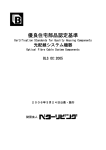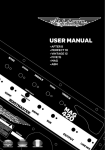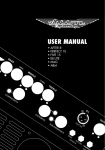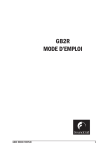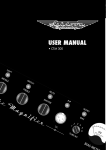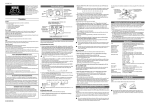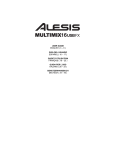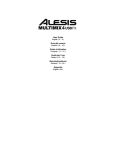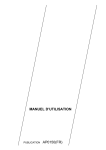Download Ashdown CTM 15 User manual
Transcript
www.ashdownmusic.com 1 USER MANUAL VALVE CTM-15 Demo Video: Thank you Thank you for purchasing your Ashdown Engineering Amplifier and welcome to the family! We really think you’ve made the right choice and know that this amplifier will give you years of great tone and service. It is a machine though and needs to be looked after, please read through this user manual which will help you get the most out of your new Amp and keep it running as long as some of our happiest and very famous customers. REGISTER ONLINE Please register this product online so we can make sure we give you years of customer support through our friendly in-house service centre. Here is where you need to visit to register your product: http://www.ashdownmusic.com/register www.ashdownmusic.com 2 Ashdown Amplifiers reserve the right to change specifications without notice. E & O E. All contents © Ashdown 2012. Ashdown Amplifiers reserve the right to change specifications without notice. E & O E. All contents © Ashdown 2012. www.ashdownmusic.com www.ashdownmusic.com 3 USER MANUAL VALVE CTM-300 CTM-100 VU FACILITIES AND CONTROLS (note that these vary according to the model) INPUTS There are two instrument inputs marked LOW and HIGH. The LOW input is highly sensitivity and also high impedance to suit the output from PASSIVE (Low Output) basses - The HIGH input is low sensitivity and lower impedance to suit the output from ACTIVE (High Output) basses. Plugging an active (High Output) bass into the LOW input will overload the input, creating a fatter, warmer and more distorted sound. Experiment by plugging your bass into either input to achieve the desired sound. On models with a single input this will be suitable for both Passive and Active basses. EFFECTS SEND AND RETURN These 1/4” jack sockets should be used to connect to an external effects device or pedal board. The EFFECTS SEND output should connect to the INPUT of the effects unit, and the output of the effects unit should be connected to the EFFECTS RETURN input Note that the signal level is at instrument level so this loop is suitable for effects pedals. EQ CONTROLS Use the MIDDLE, BASS and TREBLE controls to effect the overall tone of the sound. MID SHIFT Causes the MIDDLE control to operate at different points in the frequency spectrum dependant on the button being either in or out. BASS SHIFT Causes the Bass control to operate at different points in the frequency spectrum dependant on the button being either in or out. MELLOW Softens the overall tone slightly GAIN This controls the level of the signal sent to the MASTER section. To achieve a cleaner sound, turn the GAIN control down and the MASTER up. To achieve a richer, more distorted sound, turn the GAIN control up and the MASTER down. MASTER This controls the overall output volume of the amplifier. MUTE In the in position, this switch mutes the out put of the amplifier (useful for tuning, etc.). PRE/POST This switch determines whether the signal from the DI OUTPUT (see Rear Panel Facilities) is taken before/PRE the EQ section (down position) or after/POST (up position). VU METER The VU meter provides a visual indication of the output level of the amplifier. It also acts as a bias meter, ( not on CTM15 ) please see the following page for more details. BRIGHT Adds an overall brightness to the sound when in the up position. (Note: The BRIGHT switch is not effective when the GAIN control is set to full). 4 Ashdown Amplifiers reserve the right to change specifications without notice. E & O E. All contents © Ashdown 2012. Ashdown Amplifiers reserve the right to change specifications without notice. E & O E. All contents © Ashdown 2012. www.ashdownmusic.com www.ashdownmusic.com 5 USER MANUAL VALVE CTM-30 CTM-15 Tech Spec: REAR PANEL FACILITIES DI OUTPUT This 1/4” stereo jack socket is used to connect the amplifier to a low impedance, balanced input on a PA system or recording mixer. The signal can be taken PRE or POST EQ (see above), ie with or without the tone shaping added by the EQ section of the amplifier. On the CTM30 the DI is derived directly from the output transformer and therefore is an exact copy of the sound that you here. SPEAKER OUTPUTS There are dedicated Speakon connectors for 2, 4 and 8! load speaker cabinet configurations. It is important that the correct output or outputs are used to match the impedance load of your cabinets. Please refer to the diagrams later in this manual. CTM 30,and 15 are fitted with jack outlets at 8 and 4 ohms. OFF/PREHEAT Use this switch to pre-heat the valves, bringing them up to the correct operating temperature before performing. STANDBY/FULL No signal is sent to the speakers when this switch is in the STANDBY position. Switch to FULL when you are ready to perform. 6 www.ashdownmusic.com Ctm 300,100 AND DH200 CTM15, DH 15 Power outputs CTM 300-- 300WATTS FROM 6 XKT88 DH200 --150 WATTS FROM 4 X 6550 CTM100-- 100WATTS FROM 2 X KT88 ALL AMPLIFIERS FEATURE USER ADJUSTABLE BIASING AND 2.4 8 OHM OUTPUTS ON SPEAKON COMBI OUTLETS. Pre amplifier ( all models ) 2 x ECC832 AND 2 X ECC82 + 1 X ECC99 ( CTM300) CONTROLS Totally Passive tone shaping via Bass ,Middle Treble controls + SHIFT controls for Bass, Middle controls, Bright and Mellow switches. Gain and Master controls for clean and distorted tones VU meter Dual Function for indication of output power and tube balance and biasing EFFECTS LOOP valve driven and recovered DI out valve driven transformer coupled isolated ground with PRE/POST EQ switching. Output power 15 watts from 2 X EL84 AUTOMATIC BIAS FOR PLUG AND PLAY EASY VALVE REPLACEMENT. 4 AND 8 Ohms outputs on ¼” jack sockets Pre amplifier ( all models ) 1 x ECC83 CONTROLS Totally Passive tone shaping via Bass ,Middle Treble Gain and Master controls for clean and distorted tones VU meter for indication of output power Cool industrial wrinkle finish steel case with built in handle Head supplied with GIG bag DH15 combo also features a custom designed DUAL concentric “WHIZZER” cone speaker rated at an incredible 250 watts and a cool flip top design. CTM30, LB30 DH 30 Output power 30 watts from 4 X EL84 AUTOMATIC BIAS FOR PLUG AND PLAY EASY VALVE REPLACEMENT. 4 AND 8 Ohms outputs on ¼” jack sockets DI out Transformer derived sampled from output to include tube distortion ( isolated ground) Pre amplifier ( all models ) 2 x ECC83 AND 1X ECC82 CONTROLS Totally Passive tone shaping via Bass ,Middle Treble controls + SHIFT controls for Bass, Middle controls, Bright switch Volume control for clean and distorted tones VU meter for indication of output power EFFECTS LOOP valve driven and recovered www.ashdownmusic.com 7 USER MANUAL VALVE CTM-300/100 THE VU METER WILL STILL WORK AT REDUCED POWER IDEAL SETTING KEEP OUT! DO NOT SET ANY TUBE THIS HIGH The VU meter fitted to the CTM is a dual function meter detailed as follows: By using the push button selector switch marked “AUDIO / BIAS” the functions are accessed in the following manner: 1/ “AUDIO” - In audio mode the meter is set to read the audio output of each of the six power tubes and each can be measured by utilising the rotary selector switch on the front panel. Whilst playing this is the normal mode of operation of the meter and the reading obtained will be a direct indication of the power being produced by each output tube, the meter is calibrated so that when the needle reaches the start of the red section the power tube being measured will be producing maximum clean volume. The switch can be rotated to select any of the power tubes and its relative output will be indicated on the meter, note that when performing this test you will need to play at equal volume for each test. 2/ “BIAS” - In this mode the meter will glow RED. To check the bias of the output tubes proceed as follows: Run the amplifier for at least 10 mins to allow the output tubes to fully heat up with the amplifier set to mute. Standby on. Select.. Tube 1 and with an insulated jewelers screwdriver gently adjust the trimmer situated on the rear panel. The reading to aim for is the needle just at the start of the red ie 0db. Note that although each tube can be adjusted individually it is possible to get tubes that cannot be adjusted to the correct reading, these can still be used providing the reading is not in the red, a lower reading is acceptable and will note impact audibly on the power output or sound quality of the amplifier. Please also note that the trimmers are 25 turn types to make adjustment easy, This type of adjuster has no end stop so if you reach a point where the adjuster will not give any more adjustment then the output tube will have to be replaced if the reading is to high ie in the RED. Repeat this for each of the six output tubes in turn. RETURN THE METER TO “audio” MODE AFTER BIASING. DO NOT RUN THE AMPLIFIER IN BIAS MODE WHILST PLAYING. Note there is a protection fuse fitted to each of the output tubes and if no reading is obtained on the meter this fuse will have 8 www.ashdownmusic.com www.ashdownmusic.com 9 USER MANUAL VALVE NOTES: 10 www.ashdownmusic.com www.ashdownmusic.com 11 USER MANUAL VALVE CTM-300 CTM-100 VU EINRICHTUNGEN UND EINSTELLUNGEN (beachten Sie, dass diese je nach Modell variieren) INPUTS Es gibt zwei Eingänge für Instrumente die mit LOW-und HIGH gekennzeichnet sind. Der LOW-Eingang ist sehr empfindlich und hat auch eine hohe Impedanz um den Ausgang von passiven (Low Output) Bässen zu entsprechen. Der HIGH-Eingang ist weniger empfindlich und hat eine niedrigere Impedanz um an den Ausgang von aktiven (High Output) Bässe zu entsprechen. Das Anschließen eines aktiven (High Output) Bass in den LOW-Eingang wird zum überlasten des Eingangssignals führen und die Schaffung eines dickeren, wärmeren und verzerrten Tons ermöglichen. Experimentieren Sie, indem Sie Ihren Bass an einem der beiden Eingänge einstöpseln, um den gewünschten Klang zu erzielen. Bei Modellen mit einem einzigen Eingang eignet sich die sowohl für passive als auch aktive Bässe. Effects Send und Return Diese ¼ Inch Klinkenbuchse sollte verwendet werden, um ein externes Effektgerät oder Pedal Bord anschließen. Der EFFECTS SEND Ausgang sollte mit dem INPUT des Effektgeräts verbunden werden und der Ausgang des Effektgeräts sollte mit dem EFFECTS RETURN-Eingang verbunden werden. Beachten Sie, dass der Signalpegel dem Instrument Pegel entspricht, so dass diese Schleife für Effektpedale ist. EQ CONTROLS - Verwenden Sie die MIDDLE-, BASS- und TREBLE-Regler um den Gesamtklang des Tons zu beeinflussen. Die MID SHIFT-Taste bewirkt, dass die MIDDLE-Regler an verschiedenen Stellen im Frequenzspektrum abhängig von einander arbeiten. Dies kommt darauf an, ob der Knopf eingedrückt ist oder nicht. Der BASS SHIFT bewirkt, dass die Bass-Regler an verschiedenen Stellen im Frequenzspektrum abhängig voneinander arbeiten. Dies kommt darauf an, ob der Knopf eingedrückt ist oder nicht. Der BRIGHT-Schalter fügt eine allgemeine Helligkeit auf den Klang, wenn der Schalter sich in der oberen Position befindet. (Hinweis: Der BRIGHT-Schalter ist nicht wirksam, wenn der GAIN-Regler voll aufgedreht ist). Der MELLOW Schalter mildert den Gesamtklang leicht. 12 GAIN Regelt den Pegel des Signals das an die Master-Sektion gesendet wird. Um einen klareren Klang zu erreichen, drehen Sie den GAIN-Regler nach unten und den MASTER nach oben. Um einen reicheren, verzerrten Sound zu erreichen, drehen Sie den GAIN-Regler nach oben und den MASTER unten. MASTER Steuert die Gesamtlautstärke des Verstärkers. MUTE In der eingedrückten Position schaltet dieser Schalter der Ausgang des Verstärkers aus (nützlich für Tuning, etc.). PRE/POST Dieser Schalter bestimmt, ob das Signal aus dem DI-Ausgang (siehe Rückseite) vor die EQ-Sektion (untere Position) oder nach (obere Position) ihr gesendet werden soll. VU METER - Das VU-Meter bietet eine visuelle Anzeige der Ausgangspegel des Verstärkers. Es wirkt auch als Vorspannungsmessgerät (nicht auf CTM15). Sehen Sie auf der folgenden Seite für weitere Details nach. Ashdown Amplifiers reserve the right to change specifications without notice. E & O E. All contents © Ashdown 2012. Ashdown Amplifiers reserve the right to change specifications without notice. E & O E. All contents © Ashdown 2012. www.ashdownmusic.com www.ashdownmusic.com 13 USER MANUAL VALVE CTM-30 CTM-15 Tech Spec: RÜCKSEITE MIT EINRICHTUNGEN D.I. OUTPUT - Diese 1/4 “-Stereo-Klinkenbuchse dient dazu, den Verstärker mit einem niedrigen Impedanz und symmetrischen Eingang an einem PA-System oder einem Aufnahme Mischpult anzuschließen. Das Signal kann vor oder nach den EQ (siehe oben) geleitet werden. Zum Beispiel: mit oder ohne Ton hinzugefügter Formgebung durch die EQ des Verstärkers erfolgt. Auf der CTM30 wird die D.I. direkt von dem Ausgangs-Transformator abgeleitet und ist daher eine exakte Kopie der Sounds, den Sie hören. LAUTSPRECHER OUTPUTS - Es sind Speakon Anschlüsse für 2, 4 und 8 geladene LautsprecherboxKonfigurationen vorhanden! Es ist wichtig, dass der richtige Ausgang/die richtigen Ausgänge verwendet werden, um die Impedanz der Belastung Ihrer Kabinette anzupassen. Bitte beachten Sie die Abbildungen in diesem Handbuch. CTM 30 und 15 sind mit Buchsen Outlets in 8 und 4 Ohm ausgestattet. OFF/PREHEAT - Verwenden Sie diesen Schalter zum Vorheizen der Ventile. Die bringt sie auf die richtige Betriebstemperatur. STANDBY/FULL - Es wird kein Signal an die Lautsprecher gesendet, wenn sich dieser Schalter in der Stellung STANDBY befindet. Wechseln Sie zu FULL, wenn Sie bereit sind es durchzuführen. 14 www.ashdownmusic.com Ctm 300,100 AND DH200 CTM15, DH 15 Power outputs CTM 300-- 300WATTS FROM 6 XKT88 DH200 --150 WATTS FROM 4 X 6550 CTM100-- 100WATTS FROM 2 X KT88 ALL AMPLIFIERS FEATURE USER ADJUSTABLE BIASING AND 2.4 8 OHM OUTPUTS ON SPEAKON COMBI OUTLETS. Pre amplifier ( all models ) 2 x ECC832 AND 2 X ECC82 + 1 X ECC99 ( CTM300) CONTROLS Totally Passive tone shaping via Bass ,Middle Treble controls + SHIFT controls for Bass, Middle controls, Bright and Mellow switches. Gain and Master controls for clean and distorted tones VU meter Dual Function for indication of output power and tube balance and biasing EFFECTS LOOP valve driven and recovered DI out valve driven transformer coupled isolated ground with PRE/POST EQ switching. Output power 15 watts from 2 X EL84 AUTOMATIC BIAS FOR PLUG AND PLAY EASY VALVE REPLACEMENT. 4 AND 8 Ohms outputs on ¼” jack sockets Pre amplifier ( all models ) 1 x ECC83 CONTROLS Totally Passive tone shaping via Bass ,Middle Treble Gain and Master controls for clean and distorted tones VU meter for indication of output power Cool industrial wrinkle finish steel case with built in handle Head supplied with GIG bag DH15 combo also features a custom designed DUAL concentric “WHIZZER” cone speaker rated at an incredible 250 watts and a cool flip top design. CTM30, LB30 DH 30 Output power 30 watts from 4 X EL84 AUTOMATIC BIAS FOR PLUG AND PLAY EASY VALVE REPLACEMENT. 4 AND 8 Ohms outputs on ¼” jack sockets DI out Transformer derived sampled from output to include tube distortion ( isolated ground) Pre amplifier ( all models ) 2 x ECC83 AND 1X ECC82 CONTROLS Totally Passive tone shaping via Bass ,Middle Treble controls + SHIFT controls for Bass, Middle controls, Bright switch Volume control for clean and distorted tones VU meter for indication of output power EFFECTS LOOP valve driven and recovered www.ashdownmusic.com 15 USER MANUAL VALVE CTM-300/100 THE VU METER WILL STILL WORK AT REDUCED POWER IDEAL SETTING KEEP OUT! DO NOT SET ANY TUBE THIS HIGH VU METER - Das VU-Meter bietet eine visuelle Anzeige der Ausgangspegel des Verstärkers. Es wirkt auch als Vorspannungsmessgerät (nicht auf CTM15). Sehen Sie auf der folgenden Seite für weitere Details nach. 1/”AUDIO” - Im Audio-Modus wird der Zähler auf den Audio-Ausgang von jedem der sechs Endstufenröhren gelesen und jeder kann durch die Nutzung der Drehschalter auf der Frontplatte gemessen werden. Während der Wiedergabe wird die normale Betriebsart des Zählers erhalten und das Lesen ist ein direktes Indiz für die Leistung die von jedem Ausgangs Rohr hergestellt wird. Ist das Gerät so kalibriert, dass, wenn die Nadel Beginn des roten Abschnitts erreicht, die Endstufenröhre ein höchstmögliches sauberes Volumen erzeugt. Der Schalter kann gedreht werden, um eine der beliebigen Endstufenröhren auszusuchen. Seine relative Ausgabe wird auf dem Messgerät angezeigt werden. Beachten Sie, dass Sie bei der Durchführung dieses Tests für jeden Test in gleicher Lautstärke spielen müssen. 2/”BIAS” - In diesem Modus leuchtet das Messgerät rot. Um die Vorspannung der Endröhren zu überprüfen müssen Sie wie folgt vorgehen: Starten Sie den Verstärker für mindestens 10 Minuten, damit die Endröhren vorheizen, mit dem Verstärker auf stumm geschaltet. Standby an. Wählen Sie Röhre 1 und justieren Sie mit einem isolierten Juwelierschraubenzieher vorsichtig den Trimmer der sich auf der Rückseite befindet. Der Zielmesswert für die Nadel ist der Punkt, wo sie gerade am Beginn der roten Anzeige ankommt, das heißt bei 0db. Beachten Sie, dass, obwohl jeder Röhre individuell eingestellt werden kann, es möglich ist, dass die Röhre nicht auf korrekte Ablesung eingestellt werden kann. Diese können noch verwendet werden, vorausgesetzt der Messwert ist nicht im roten Bereich. Ein geringer Messwert ist akzeptabel und Sie werden Auswirkungen hören; beachten Sie die Leistung oder Klangqualität des Verstärkers. Bitte beachten Sie auch, dass die Trimmer 25 wiederum Typen sind, um Anpassungen einfach zu gestalten. Diese Art der Einstellung hat keinen Endanschlag. Wenn Sie also einen Punkt erreichen, wo der Regler nicht mehr Anpassung ermöglicht, dann muss die Endröhre, wenn der Messwert ist zu hoch, das heißt in die Anzeige rot ist, ersetzt werden. Wiederholen dieses für jede der sechs Ausgangs Rohre in der Reihe. Stellen Sie das Messgerät auf den “Audio”-Modus nach der Vorspannung. Benutzen Sie den Verstärker in BIAS MODE während des Spielens. Anmerkung: Es gibt eine Schutzsicherung, angepasst auf jede der Endröhren und wenn keine Ablesung auf dem Zähler erscheint, wird diese Sicherung wohl versagt haben. Die Sicherungen befinden sich neben dem Ausgangs befindet. sie schützen die korrekte Bewertung, die 315mA flink ist. im Falle einer durchgebrannten Sicherung müssen sie mit Sicherungen mit dem korrekten Wert und Typ ersetzt werden. Die Sicherungen befinden sich neben dem Ausgang. Sie schützen die korrekte Bewertung, die 315mA quick blow ist. Im Falle einer durchgebrannten Sicherung müssen sie mit Sicherungen mit dem korrekten Wert und Typ ersetzen. Ein ständiges Blasen der Sicherung würde bedeuten, dass entweder eine falsch voreingenommenene Ausgangs Röhre oder eine defekte Endröhre das Problem sind.failed. 16 www.ashdownmusic.com www.ashdownmusic.com 17 USER MANUAL VALVE NOTES: 18 www.ashdownmusic.com www.ashdownmusic.com 19 USER MANUAL VALVE CTM-300 CTM-100 VU FACILITIES AND CONTROLS (note that these vary according to the model) INPUTS There are two instrument inputs marked LOW and HIGH. The LOW input is highly sensitivity and also high impedance to suit the output from PASSIVE (Low Output) basses - The HIGH input is low sensitivity and lower impedance to suit the output from ACTIVE (High Output) basses. Plugging an active (High Output) bass into the LOW input will overload the input, creating a fatter, warmer and more distorted sound. Experiment by plugging your bass into either input to achieve the desired sound. On models with a single input this will be suitable for both Passive and Active basses. EFFECTS SEND AND RETURN These 1/4” jack sockets should be used to connect to an external effects device or pedal board. The EFFECTS SEND output should connect to the INPUT of the effects unit, and the output of the effects unit should be connected to the EFFECTS RETURN input Note that the signal level is at instrument level so this loop is suitable for effects pedals. EQ CONTROLS Use the MIDDLE, BASS and TREBLE controls to effect the overall tone of the sound. MID SHIFT Causes the MIDDLE control to operate at different points in the frequency spectrum dependant on the button being either in or out. BASS SHIFT Causes the Bass control to operate at different points in the frequency spectrum dependant on the button being either in or out. MELLOW Softens the overall tone slightly GAIN This controls the level of the signal sent to the MASTER section. To achieve a cleaner sound, turn the GAIN control down and the MASTER up. To achieve a richer, more distorted sound, turn the GAIN control up and the MASTER down. MASTER This controls the overall output volume of the amplifier. MUTE In the in position, this switch mutes the out put of the amplifier (useful for tuning, etc.). PRE/POST This switch determines whether the signal from the DI OUTPUT (see Rear Panel Facilities) is taken before/PRE the EQ section (down position) or after/POST (up position). VU METER The VU meter provides a visual indication of the output level of the amplifier. It also acts as a bias meter, ( not on CTM15 ) please see the following page for more details. BRIGHT Adds an overall brightness to the sound when in the up position. (Note: The BRIGHT switch is not effective when the GAIN control is set to full). 20 Ashdown Amplifiers reserve the right to change specifications without notice. E & O E. All contents © Ashdown 2012. Ashdown Amplifiers reserve the right to change specifications without notice. E & O E. All contents © Ashdown 2012. www.ashdownmusic.com www.ashdownmusic.com 21 USER MANUAL VALVE CTM-30 CTM-15 Tech Spec: REAR PANEL FACILITIES DI OUTPUT This 1/4” stereo jack socket is used to connect the amplifier to a low impedance, balanced input on a PA system or recording mixer. The signal can be taken PRE or POST EQ (see above), ie with or without the tone shaping added by the EQ section of the amplifier. On the CTM30 the DI is derived directly from the output transformer and therefore is an exact copy of the sound that you here. SPEAKER OUTPUTS There are dedicated Speakon connectors for 2, 4 and 8! load speaker cabinet configurations. It is important that the correct output or outputs are used to match the impedance load of your cabinets. Please refer to the diagrams later in this manual. CTM 30,and 15 are fitted with jack outlets at 8 and 4 ohms. OFF/PREHEAT Use this switch to pre-heat the valves, bringing them up to the correct operating temperature before performing. STANDBY/FULL No signal is sent to the speakers when this switch is in the STANDBY position. Switch to FULL when you are ready to perform. Ctm 300,100 AND DH200 Power outputs CTM 300-- 300WATTS FROM 6 XKT88 DH200 --150 WATTS FROM 4 X 6550 CTM100-- 100WATTS FROM 2 X KT88 ALL AMPLIFIERS FEATURE USER ADJUSTABLE BIASING AND 2.4 8 OHM OUTPUTS ON SPEAKON COMBI OUTLETS. Pre amplifier ( all models ) 2 x ECC832 AND 2 X ECC82 + 1 X ECC99 ( CTM300) CONTROLS Totally Passive tone shaping via Bass ,Middle Treble controls + SHIFT controls for Bass, Middle controls, Bright and Mellow switches. Gain and Master controls for clean and distorted tones VU meter Dual Function for indication of output power and tube balance and biasing EFFECTS LOOP valve driven and recovered DI out valve driven transformer coupled isolated ground with PRE/POST EQ switching. Output power 15 watts from 2 X EL84 AUTOMATIC BIAS FOR PLUG AND PLAY EASY VALVE REPLACEMENT. 4 AND 8 Ohms outputs on ¼” jack sockets Pre amplifier ( all models ) 1 x ECC83 CONTROLS Totally Passive tone shaping via Bass ,Middle Treble Gain and Master controls for clean and distorted tones VU meter for indication of output power Cool industrial wrinkle finish steel case with built in handle Head supplied with GIG bag DH15 combo also features a custom designed DUAL concentric “WHIZZER” cone speaker rated at an incredible 250 watts and a cool flip top design. CTM30, LB30 DH 30 Output power 30 watts from 4 X EL84 AUTOMATIC BIAS FOR PLUG AND PLAY EASY VALVE REPLACEMENT. 4 AND 8 Ohms outputs on ¼” jack sockets DI out Transformer derived sampled from output to include tube distortion ( isolated ground) Pre amplifier ( all models ) 2 x ECC83 AND 1X ECC82 CONTROLS Totally Passive tone shaping via Bass ,Middle Treble controls + SHIFT controls for Bass, Middle controls, Bright switch Volume control for clean and distorted tones VU meter for indication of output power EFFECTS LOOP valve driven and recovered CTM15, DH 15 22 www.ashdownmusic.com www.ashdownmusic.com 23 USER MANUAL VALVE CTM-300/100 THE VU METER WILL STILL WORK AT REDUCED POWER IDEAL SETTING KEEP OUT! DO NOT SET ANY TUBE THIS HIGH The VU meter fitted to the CTM is a dual function meter detailed as follows: By using the push button selector switch marked “AUDIO / BIAS” the functions are accessed in the following manner: 1/ “AUDIO” - In audio mode the meter is set to read the audio output of each of the six power tubes and each can be measured by utilising the rotary selector switch on the front panel. Whilst playing this is the normal mode of operation of the meter and the reading obtained will be a direct indication of the power being produced by each output tube, the meter is calibrated so that when the needle reaches the start of the red section the power tube being measured will be producing maximum clean volume. The switch can be rotated to select any of the power tubes and its relative output will be indicated on the meter, note that when performing this test you will need to play at equal volume for each test. 2/ “BIAS” - In this mode the meter will glow RED. To check the bias of the output tubes proceed as follows: Run the amplifier for at least 10 mins to allow the output tubes to fully heat up with the amplifier set to mute. Standby on. Select.. Tube 1 and with an insulated jewelers screwdriver gently adjust the trimmer situated on the rear panel. The reading to aim for is the needle just at the start of the red ie 0db. Note that although each tube can be adjusted individually it is possible to get tubes that cannot be adjusted to the correct reading, these can still be used providing the reading is not in the red, a lower reading is acceptable and will note impact audibly on the power output or sound quality of the amplifier. Please also note that the trimmers are 25 turn types to make adjustment easy, This type of adjuster has no end stop so if you reach a point where the adjuster will not give any more adjustment then the output tube will have to be replaced if the reading is to high ie in the RED. Repeat this for each of the six output tubes in turn. RETURN THE METER TO “audio” MODE AFTER BIASING. DO NOT RUN THE AMPLIFIER IN BIAS MODE WHILST PLAYING. Note there is a protection fuse fitted to each of the output tubes and if no reading is obtained on the meter this fuse will have Face avant Face arrièrE Face avant Inputs Vous disposez d’une entrée et d’un interrupteur vous permettant de choisir le type d’impédance de l’instrument utilisé. Passive et Active. Le mode Passif (interrupteur relâché) offre une haute sensibilité et une haute impédance pour s’adapter aux basses passives. Le mode actif (interrupteur enfoncé) offre une sensibilité et une impédance nettement plus basse afin de correspondre au signal provenant d’une basse active. INPUT CONTROL Le réglage input control permet de définir le niveau du signal d’entrée dans le préampli en coordination avec le vu- mètre; Il doit être réglé de façon à ce que la valeur moyenne soit 0vu et en obtenant des pics occasionnels en zone rouge. Notez que ces paramètres pourront être réajustes après avoir modifié les valeurs d’égalistation. PUSH FLAT/SHAPE En position relâché, ce bouton enclenche un circuit de préégalisation fixe qui donne au son une certaine clarté et un caractère punchy. Appuyer sur ce bouton pour obtenir une égalisation plate. Cette fonction peut également être contrôlée par une pédale, pour que la pédale soit opérationnelle le bouton doit être en position off. VALVE DRIVE Cette fonction permet d’acheminer le signal soit vers une section d’amplificateur à transistors (son clair), soit vers une section d’amplification à lampes double triode afin d’y ajouter du caractère; de la chaleur avec un réglages à 9h ; un léger grain sur 12h ; et jusqu’à la saturation des lampes lorsque le réglage est amené au maximum. Un mélange des deux sections d’amplification peut être réalisé avec ce réglage. N.B : la quantité de saturation est également dépendante du réglage du gain d’entrée. 24 www.ashdownmusic.com VALVE DRIVE/IN OUT Ce bouton active/désactive la fonction Valve Drive. Cette fonction peut également être accessible à partir du pédalier FS4 en option (pour que le pédalier fonctionne, cette fonction doit être désactivée). EQ IN/OUT Ce bouton active ou désactive la section Egalisation. Cette fonction peut également être accessible à partir du pédalier FS4 en option (pour que le pédalier fonctionne, cette fonction doit être désactivée). EQUALISER La section d’égalisation comprend les réglages « BASS/ MIDDLE/ TREBLE» (Graves/ Mediums/ Aigus) et les deux jeux de potentiomètres linéaires placés entre ceux-ci. Vous pouvez utiliser cet égaliseur de deux manières différentes : 1- Comme un simple réglage des tonalités graves, médiums et aigües, que l’on trouve traditionnellement sur nombre d’amplificateurs classiques. Vous laisserez alors les deux jeux de potentiomètres linéaires placés entre ceux-ci en position centrale et n’utiliserez que les boutons « BASS/ MIDDLE/ TREBLE» (Graves/ Mediums/ Aigus) pour régler la tonalité générale. 2 - Comme un égaliseur polyvalent, simple à comprendre et à régler. En plus des réglages « BASS/ MIDDLE/ TREBLE», vous utiliserez les deux jeux de potentiomètres linéaires placés entre ceux-ci qui vous permettront de façonner le son à votre guise, en travaillant sur le Bas et le Haut medium. Cette section se caractérise donc par la simplicité d’un réglage de tonalité à trois boutons avec la flexibilité d’un égaliseur graphique. COMPRESSION L’ajout d’une faible quantité de compression vous permet de donner un son beaucoup plus profond et de jouer à un volume plus élevé sans attaquer les cordes plus fort ce qui permet d’éviter les pics de distorsion de l’étage de sortie de l’amplificateur. Vous trouverez également que le son sera plus défini en mettant en valeur la dynamique de votre jeu et en offrant également une meilleur définition. www.ashdownmusic.com 25 USER MANUAL VALVE Une valeur de compression élevée peut être utilisée comme un effet mais elle aura tendance à réduire la dynamique de votre jeu de manière à ce que le volume des notes reste le même, que les cordes soient jouées plus ou moins durement. La compression permet également d’ajouter du sustain aux notes jouées en maintenant leur volume les rendant ainsi plus longues. Le potentiomètre ajuste le niveau de compression appliquée. Pour que cela fonctionne correctement le niveau d’entre doit être correctement réglé comme décrit précédemment. Lorsque le niveau d’entrée est correctement règle il n’y aura quasiment aucune différence de volume que la compression soit activée ou non. L’ampli compense automatiquement la réduction du niveau en augmentant le gain global pour le restaurer à son niveau de pré compression. A cause de ceci vous remarquerez peut être une augmentation du bruit de fond avec des valeurs élevées. NOTES: COMPRESSION IN / OUT - Ce bouton-poussoir permet d’activer/désactiver la compression. Cette fonction peut également être commandée à partir du pédalier Ashdown FS-4. Pour que le pédalier fonctionne ce bouton doit être sur la position OUT. SUB HARMONICS Cette section est constituée d’un interrupteur IN / OUT et d’un contrôle de niveau. Lorsque l’interrupteur est en position IN, des Sub Harmoniques à l’octave inférieure aux notes jouées sont produites. Le niveau de ces Sub Harmoniques par rapport au son de basse direct peut être ajusté en utilisant le contrôle de niveau. Ceci est très efficace pour épaissir le son et vous constaterez à l’usage qu’il suffit d’un dosage minime de cette octave inférieure pour vraiment remplir le son en lui donnant un caractère qu’il n’est pas possible d’obtenir par d’autres moyens. Le niveau de Sub Harmonics est aussi dépendant de la valeur du potentiomètre BASS. Cette fonction s’active/désactive à l’aide du bouton situé à gauche du potentiomètre de contrôle Sub Harmonics. DIRECT INJECT Une sortie D.I. symétrique est disponible sur la face avant avec une prise XLR en métal à verrouillage. Un bouton poussoir situé sur la face avant vous permet de choisir si le signal sortant de cette prise XLR est Pré E.Q (bouton enclenché) ou s’il est post EQ, Post Sub et Post Effets (bouton relaché). Il est et calibré pour permettre de se connecter à l’entrée microphone d’une table de mixage, pour l’injection directe dans un système de sonorisation ou pour enregistrer. Elle doit SEULEMENT être utilisée pour se connecter à une entrée microphone symétrique. Elle n’est pas prévue pour tout autre type de connexion. Elle dispose d’une terre flottante calibrée pour la console de mixage à laquelle elle va être connectée et ne nécessite pas de mise à la terre. Elle n’est pas non plus affectée par l’alimentation fantôme d’une entrée microphone. Assurez-vous que votre fiche XLR n’a pas une connexion interne à la terre car cela relierait le système à la terre du châssis de l’amplificateur et pourrait causer des problèmes de ronflements. PUSH TO MUTE En pressant sur ce bouton on mute (Mode muet) : la sortie du pré-ampli à l’ampli de puissance, la sortie DI et la sortie ligne tout en laissant en fonction la sortie accordeur. Une Led placée à cote du bouton poussoir s’allume lorsque l’amplificateur est mis en mode mute. Cette fonction ne peut se faire qu’à partir du bouton poussoir mute situe sur le panneau avant. En pressant ce bouton poussoir tous les sons de l’amplificateur sont coupes ce qui permet le réglage silencieux de votre basse via la prise accordeur. Relâchez ce bouton et vous voila à nouveau en action. TUNER OUT Cette sortie présente un signal de niveau ligne qui peut être utilisée autant pour une connexion permanente à un accordeur que comme une sortie ligne pour asservir d’autres amplificateurs de puissance. Elle fonctionne même si l’ampli est mis en mode mute. LIGNE OUT Ce connecteur de sortie délivre un signal de niveau ligne pour le raccordement à un amplificateur de puissance externe pilotant des hauts parleurs additionnels. NIVEAU DE SORTIE - La commande du niveau de sortie vous permet d’ajuster le niveau global de votre amplificateur. Ne le faites pas fonctionner pendant de longues périodes de temps à un volume élevé sans protections auditives, ou à un niveau sonore qui provoque des malaises. PANNEAU ARRIÈRE ENTREE LIGNE - Le panneau arrière dispose d’une entrée ligne permettant la connexion d’autres sources de signal dans le système. Ceci peut être utilisé pour brancher un CD ou Lecteur MP3 dans l’amplificateur pour pratiquer, répéter ou pour connecter un deuxième préampli. EFFECTS/SEND AND RETURN Une boucle d’insertion d’effets est disponible et elle offre un niveau de 0dB . Au besoin, la sortie EFFECTS SEND peut aussi être utilisée comme une sortie ligne. Le chemin du signal à travers le préampli est rompu seulement lorsqu’un jack est inséré dans la prise EFFECTS RETURN. La prise EFFECTS SEND prélève le signal après l’E.Q, le préampli, la compression et le Processeur Sub Harmonics. Connecteur 4-WAY FOOTSWITCH - Connecteur jack 6,35 mm pour pédalier Ashdown FS-4 uniquement. Pour que le pédalier fonctionne il est impératif que tous les boutons correspondants aux fonctions contrôlées soient en position OUT. Toujours raccorder le pédalier avant la mise sous tension de l’amplificateur car la pédale est alimentée par l’amplificateur et elle envoie une série de données à l’amplificateur afin d’exploiter ces différentes fonctions. Chacune des 4 fonctions disponibles pour la sélection est indiquée par une LED qui sera s’allume lorsque cette fonction est sélectionné à partir de la pédale. 26 www.ashdownmusic.com www.ashdownmusic.com 27 www.ashdownmusic.com Ashdown Design & Marketing Ltd Stevens Farm (The Stables), Mashbury Road, Chignal St James, Chelmsford, Essex CM1 4TX
This document in other languages
- français: Ashdown CTM 15
- Deutsch: Ashdown CTM 15















